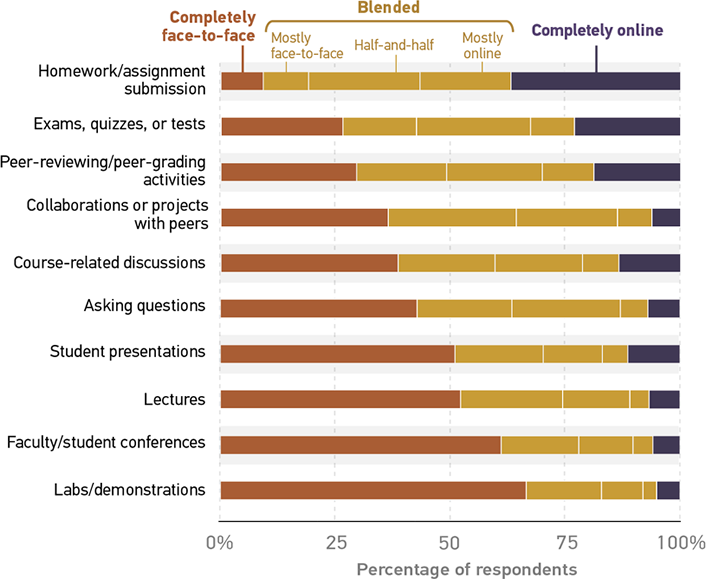As many colleges and universities move instruction online as part of their response to COVID-19, data about user preferences, access, and training can help ease that transition for students and faculty.

The COVID-19 pandemic is prompting many colleges and universities to abruptly and comprehensively adopt online learning in place of face-to-face classes, in an effort to limit transmission of the virus. Faculty, students, and support staff are all working to accommodate this massive change. EDUCAUSE research on student, faculty, and institutional readiness for online learning can help institutions better understand the pre-COVID-19 perspectives and status of their faculty, students, and organizations. This research summary is one of a series of reports outlining higher education's readiness to move teaching and learning online to preserve and continue its educational mission during the current pandemic.
Device Access
Most, but not all, students have access to digital devices that could be used for online learning (see table 1). Institutions should be prepared to make accommodations for students who either do not have access to devices at all or lack devices that are compatible with the institutional LMS. Access varies significantly by institution type.
Table 1. Device access among community college and four-year students
|
Device |
Community college students |
Four-year students |
|---|---|---|
|
Smartphone |
96.3% |
97.9% |
|
Laptop |
89.8% |
92.2% |
|
Tablet |
44.8% |
33.5% |
|
Desktop |
44.4% |
30.8% |
|
Hybrid or 2-in-1 device (e.g., Lenovo Yoga, Microsoft Surface) |
10.4% |
11.3% |
LMS Use
Most students have some experience using the LMS for their courses (mostly accessing the syllabus or checking grades; see table 2), but a sizable portion of students have minimal experience using online classroom platforms, especially for more-involved course activities. As a general rule, providing students with instructions on how to use the LMS and advice for navigating the peculiarities of particular courses can improve their learning experiences. Patience and lenience are the order of the day with students who might have a difficult time accessing and using the platform. Instructors should plan for the additional time this will take when moving abruptly to online learning. IT support staff should be prepared to provide just-in-time support for these cases. Additionally, consider using asynchronous and flexible approaches to teaching and deadlines to accommodate students with constraints or emergencies that would prevent them from attending synchronous events or who lack reliable Wi-Fi or broadband access.
Table 2. Students' LMS use
|
Students who used the LMS for... |
Percentage |
|---|---|
|
All of their courses |
68.3% |
|
Most of their courses |
21.2% |
|
About half of their courses |
4.5% |
|
At least one of their courses |
2.6% |
|
None of their courses |
3.4% |
LMS Training
It's time to ramp-up your LMS training program. Although 99% of institutions provide LMS and educational technology support for students, a majority of students have either not received any LMS training or don't know if they have received training; more students at AA institutions have received formal LMS training than students at other types of institutions (see table 3). The lack of formal LMS training poses serious issues for institutions requiring that courses be moved online in response to the COVID-19 pandemic. Institutions should not assume that students with no formal LMS training will be able to move easily into online learning environments. In addition to faculty needing to provide coaching for their particular courses, IT support services might find themselves overwhelmed by students seeking advice or needing to troubleshoot problems as they begin to take all of their courses online.
Table 3. Students' LMS training experiences
|
|
No |
Yes, mandatory training |
Yes, optional training |
Don't know |
|---|---|---|---|---|
|
AA |
21.2% |
10.8% |
25.1% |
42.9% |
|
BA |
30.6% |
9.0% |
16.6% |
43.8% |
|
MA |
32.4% |
6.5% |
15.4% |
45.8% |
|
DR |
33.2% |
4.6% |
15.7% |
46.5% |
Learning Environments Preferences
The completely online learning environments into which students' courses are being migrated in response to COVID-19 will be suboptimal relative to student preferences. Nearly all students prefer at least some face-to-face contact, with a majority preferring that their classes be mostly to completely face-to-face (see figure 1). While some groups of students have a stronger preference for completely online courses based on their personal circumstances, most still prefer at least a little face-to-face engagement. It is possible that some students will resist the completely online experience and might disengage or not perform as well as they might otherwise, given their preferences for other types of learning environments. It is critical that faculty migrating face-to-face courses to completely online ones create engaging and thoughtful learning experiences to improve student buy-in to and experiences with the online environment. Both faculty and students will need support from others in the institution, whether that be IT to help them come up to speed, teaching and learning centers to help faculty revise their curricula and teaching methods, or student advising and success officers to understand the potential speed bumps this might introduce to course and degree completion.

Learning Environment Preferences for Activities and Assignments
Students also have strong preferences for the type of classroom activities and assignments they conduct in a completely online environment (see figure 2). Submitting homework and assignments; taking exams, quizzes, or tests; conducting peer-reviewing or peer-grading activities; and having course-related discussions are the activities that students most often prefer to conduct in a completely online environment the most, but relatively few students prefer this environment even for the activities most suited to it. Understanding these preferences can help faculty make decisions about how to convert or whether to jettison activities and assignments that were originally designed for face-to-face learning environments. These data may also help teaching and learning center staff develop focused support for helping understand and address the root causes of students' preferences.

The COVID-19 pandemic is presenting higher education with a host of unprecedented challenges. Moving all courses with face-to-face components to completely online environments is new territory for students, faculty, and institutions. Fortunately, we know that online learning works, and we know a lot about how teaching and learning works in online environments. And, while there is an abundance of IT, teaching and learning, and instructional design resources that can facilitate the academic triage currently under way, institutions will need to provide expanded support and additional channels of support to help students. Our efforts here draw upon current EDUCAUSE student, faculty, and institutional data to help higher education employees anticipate potential problems as they move all of their course offerings online.
Read about faculty readiness to adopt fully online learning. EDUCAUSE will continue to monitor higher education and technology related issues during the course of the COVID-19 pandemic. For additional resources, please visit the EDUCAUSE COVID-19 web page.
For more information and analysis about higher education IT research and data, please visit the EDUCAUSE Review Data Bytes blog as well as the EDUCAUSE Center for Analysis and Research.
D. Christopher Brooks is Director of Research at EDUCAUSE.
Susan Grajek is Vice President of Communities and Research at EDUCAUSE.
© 2020 D. Christopher Brooks and Susan Grajek. The text of this work is licensed under a Creative Commons BY-NC-ND 4.0 International License.
